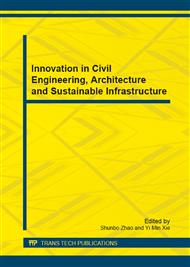p.823
p.826
p.833
p.838
p.844
p.848
p.852
p.856
p.860
Study on Relationship of Seismic and Pseudo Response Spectrums
Abstract:
153 seismic waves were input into the elastic-dynamic differential equations of single degree of freedom system, the acceleration response spectrum, velocity response spectrum and displacement response spectrum in different site characteristic periods were obtained. According to the pseudo-dynamic relationship between acceleration, velocity and displacement response spectrum, the pseudo response spectra were obtained by the deduction of the 3 real response spectra from the frequency relation. Compared with the value of the real and the pseudo response spectra, the basic characteristics and differences were studied, the correction formulas of the difference between the real response spectrum and the pseudo response spectrum were obtained, the correction formula will contribute to the development of performance based seismic design theory.
Info:
Periodical:
Pages:
844-847
Citation:
Online since:
November 2012
Authors:
Price:
Сopyright:
© 2012 Trans Tech Publications Ltd. All Rights Reserved
Share:
Citation:


